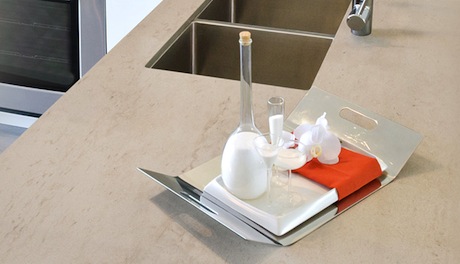Cosentino Stone and Why Surfaces Matter
On this site, the spotlight tends to shine brightest on sexy items like transforming furniture and architecture as they are the most conspicuous elements that make small spaces work in big ways. But there are other less sexy–though often beautiful–things that make small spaces work. One of those things is the choice of surface materials. Whereas large spaces can obscure cheap materials, small spaces shine a magnifying glass on them. It was for this reason that we chose Eco stone by Cosentino for many of the surfaces in the LifeEdited apartment.
We used Eco for a number of reasons. First, it looks great. We chose their polished Polar Cap color, a primarily white finish with a touch of blue-grey. It has a tight aggregate composition with a subtle sparkle in it. It matches the rest of the apartment without matching it too well.
Close behind aesthetics was its eco-cred. 75% of Eco’s composition is recycled mirror, glass, porcelain, earthenware and vitrified ash. The other 25% is natural stone and resins. Even 94% of the water used in its manufacturing is reused. Eco is LEED compliant and achieves the strict Cradle to Cradle certification, which seeks “to re-use every element, returning the product to the land as a ‘biological nutrient’ or to the industry as ‘technical nutrient’, so as to be recycled all over again.”
We used the material on the kitchen and bathroom sink counters, the walls of the toilet room and the window sills. Throughout the house, it’s maintained a nice finish and been stain free, and its sealed surface requires no upkeep.
Dekton
Cosentino North America invited us to the launch of their new product, Dekton. While it lacks Eco’s eco cred, Dekton has a very interesting story.
Using a process Cosentino calls Particle Sintering Technology (PST), they make Dekton essentially the way real stone is made. First, a blend of refined glass, porcelain, and natural quartz is heated to 1200 degrees celsius–a temperature equivalent to the core of the earth. The material is then cooled to the point where it becomes magma; they then apply 25,000 tons of pressure to this composition. According to Cosentino, this pressure is “six times more than what has been regarded as the world’s largest press up to now.” Because Cosentino was essentially trying to replicate the even force of a mountain bearing down on magma, the press and oven they use is the size of two football fields. In nature, this process takes 20-30,000 years. At Cosentino’s Spanish factory, it takes four hours.
The result is a material that’s virtually impervious to scratching, staining, UV light, water, cold and fire. It is so strong and versatile, Cosentino is touting it as much for exterior applications like building cladding as indoor ones like countertops and floors. It’s available in 12 white, grey, black, and natural stone hues and in three polished, matte, and slate finishes.
Cosentino, as part of NYC’s Archtober festival, created an exhibition called “Surface Innovation: Redefining Boundaries of Interior and Exterior Spaces.” As exterior and interior materials are seldom the same, Cosentino brought together several architects and asked them to conceptualize what they’d do with a material that could provide continuity inside and out of a structure (i.e. Dekton). Check out what they came up with at the exhibition, which runs through the end of the month (click here for details).
What does all this have to do with small space, minimal living you ask? We like to think that the concept of “less, but better” can apply anywhere–from a pair of pants to a countertop. We chose the Eco countertop because it fits that bill, matching aesthetics, function and responsible manufacturing processes. And while Dekton lacks the the green pedigree of Eco, the concept of a material impervious to most any abuse, that could seemingly last forever, that can be applied anywhere and looks great, seems to fit that bill as well.
[Full disclosure: Though we chose the “Eco” material independently, Cosentino provided sponsorship of our first apartment.]






